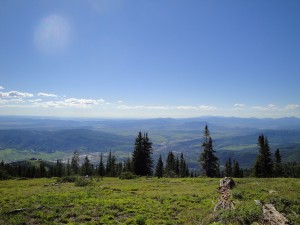
Looking west from the Storm Peak Laboratory
Collaborative Research: Hygroscopic Properties of Aerosol Organics
NSF Atmospheric Chemistry Program, 2009-2012
Aerosols affect the Earth’s radiation balance directly by scattering sunlight and indirectly through their role as cloud condensation nuclei (CCN). An increase in the number of CCN leads to more numerous but smaller cloud droplets and increased cloud albedo. Current estimates of direct and indirect effects, -0.9 to -0.1 and -1.8 to -0.3 W m-2, respectively, remain uncertain because of our inability to accurately estimate the spatial and temporal distributions of aerosol concentrations, size, and composition. The “direct” effect is enhanced for hygroscopic aerosols, which absorb water as a function of relative humidity, grow in size, and scatter more light. The indirect effect depends on ability of aerosols to grow into cloud drops. Absorption of water vapor by aerosols to produce haze and cloud droplets depends on size and chemical composition of the dry particles.
In this project, we focus on the comprehensive identification of aerosol organic matter components to determine model compounds for input into climate models. Accurate model predictions of the effects of aerosol upon Earth’s radiative balance are urgently needed. Structural determination of aerosol organic compounds is quite complex since they are a result of several hundred to a few thousand individual compounds with variable oxygen to carbon ratios. Time resolved sample collection and corresponding analyses will provide useful information regarding the relative significance of the hypothesized model compounds. We are working with investigators at the Desert Research Institute (Drs. Gannet Hallar (Lead PI), Doug Lowenthal, Barbara Zielinska), University of California-Davis (Dr. Simon L Clegg), and Texas A&M University (Dr. Donald R Collins).
Representative Publications:
Samburova, V., A.G. Hallar, L.R. Mazzoleni, P. Saranjampour, D.H. Lowenthal, S. Kohl, and B. Zielinska, Composition of Water-Soluble Organic Carbon of Nonurban Atmospheric Aerosols Collected at the Storm Peak Laboratory, Environmental Chemistry, 10, 370-380, 2013.
Hallar, A.G., D.H. Lowenthal, S.L. Clegg, V. Samburova, N. Taylor, L.R. Mazzoleni, B. Zielinska, T. Kristensen, G. Chirokova, I.B. McCubbin, C. Dodson, and D. Collins, Chemical and Hygroscopic Properties of Aerosol Organics at the Storm Peak Laboratory, Journal of Geophysical Research, 118, doi: 10.1002/jgrd.50373, 2013.
Mazzoleni, L.R., P. Saranjampour, M.M. Dalbec, V. Samburova, B. Zielinska, A.G. Hallar, D. Lowenthal, and S. Kohl, Identification of Water-Soluble Organic Carbon in Nonurban Organic Aerosols using Ultrahigh-Resolution FT-ICR Mass Spectrometry: Organic Anions, Environmental Chemistry, 9(3) 285-297, 2012. Invited Contribution

